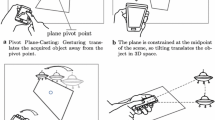Abstract
The Pie Segment Slider is a novel parameter control interface combining the advantages of tangible input with the customizability of a graphical interface representation. The physical part of the interface consists of a round touchpad, which serves as an appropriate sensor for manipulating ring-shaped sliders arranged around a virtual object. The novel interface concept allows to shift a substantial amount of interaction task time from task preparation to its exploratory execution. Our user study compared the task performance of the novel interface to a common touchpad-operated GUI and examined the task sequences of both solutions. The results confirm the benefits of exploiting tangible input and proprioception for operating graphical user interface elements.
Preview
Unable to display preview. Download preview PDF.
Similar content being viewed by others
References
Blasko, G., Feiner, S.: An interaction system for watch computers using tactile guidance and bidirectional segmented strokes. In: ISWC 2004: Proceedings of the Eighth International Symposium on Wearable Computers, pp. 120–123. IEEE Computer Society, Washington (2004)
Butz, A., Groß, M., Krüger, A.: Tuister: a tangible ui for hierarchical structures. In: IUI 2004: Proceedings of the 9th international conference on Intelligent user interfaces, pp. 223–225. ACM, New York (2004)
Callahan, J., Hopkins, D., Weiser, M., Shneiderman, B.: An empirical comparison of pie vs. linear menus. In: CHI 1988: Proceedings of the SIGCHI conference on Human factors in computing systems, pp. 95–100. ACM, New York (1988)
Card, S.K., Moran, T.P., Newell, A.: The keystroke-level model for user performance time with interactive systems. Commun. ACM 23(7), 396–410 (1980)
Card, S.K., Newell, A., Moran, T.P.: The Psychology of Human-Computer Interaction. L. Erlbaum Associates Inc., Hillsdale (1983)
Fitts, P.: The Information Capacity of the Human Motor System in Controlling the Amplitude of Movement. Journal of Experimental Psychology 47, 381–391 (1954)
Fitzmaurice, G.W., Ishii, H., Buxton, W.: Bricks: Laying the foundations for graspable user interfaces. In: CHI, pp. 442–449 (1995)
Göttel, T.: Probono: transferring knowledge of virtual environments to real world situations. In: IDC 2007: Proceedings of the 6th international conference on Interaction design and children, pp. 81–88. ACM, New York (2007)
Guimbretiére, F., Winograd, T.: Flowmenu: combining command, text, and data entry. In: UIST 2000: Proceedings of the 13th annual ACM symposium on User interface software and technology, pp. 213–216. ACM, New York (2000)
Hinckley, K., Pausch, R., Goble, J.C., Kassell, N.F.: Passive real-world interface props for neurosurgical visualization. In: CHI 1994: Conference companion on Human factors in computing systems, p. 232. ACM, New York (1994)
Hopkins, D.: The design and implementation of pie menus. Dr. Dobb’s J. 16(12), 16–26 (1991)
John, B.E., Kieras, D.E.: The goms family of user interface analysis techniques: comparison and contrast. ACM Trans. Comput.-Hum. Interact. 3(4), 320–351 (1996)
Kok, A.J.F., van Liere, R.: Co-location and tactile feedback for 2d widget manipulation. In: VR 2004: Proceedings of the IEEE Virtual Reality 2004, p. 233. IEEE Computer Society, Washington (2004)
Kurtenbach, G.: Some articulatory and cognitive aspects of marking menus: an empirical study. Human Computer Interaction 8(2), 1–23 (1993)
Lee, E.: Towards a quantitative analysis of audio scrolling interfaces. In: CHI 2007: CHI 2007 extended abstracts on Human factors in computing systems, pp. 2213–2218. ACM, New York (2007)
Moscovich, T., Hughes, J.F.: Navigating documents with the virtual scroll ring. In: UIST 2004: Proceedings of the 17th annual ACM symposium on User interface software and technology, pp. 57–60. ACM, New York (2004)
Pook, S., Lecolinet, E., Vaysseix, G., Barillot, E.: Control menus: excecution and control in a single interactor. In: CHI 2000: CHI 2000 extended abstracts on Human factors in computing systems, pp. 263–264. ACM, New York (2000)
Rekimoto, J., Ullmer, B., Oba, H.: Datatiles: a modular platform for mixed physical and graphical interactions. In: CHI 2001: Proceedings of the SIGCHI conference on Human factors in computing systems, pp. 269–276. ACM, New York (2001)
Smith, G.M., Schraefel, M.C.: The radial scroll tool: scrolling support for stylus- or touch-based document navigation. In: UIST 2004: Proceedings of the 17th annual ACM symposium on User interface software and technology, pp. 53–56. ACM, New York (2004)
Ullmer, B., Sankaran, R., Jandhyala, S., Tregre, B., Toole, C., Kallakuri, K., Laan, C., Hess, M., Harhad, F., Wiggins, U., Sun, S.: Tangible menus and interaction trays: core tangibles for common physical/digital activities. In: TEI 2008: Proceedings of the 2nd international conference on Tangible and embedded interaction, pp. 209–212. ACM, New York (2008)
Underkoffler, J., Ishii, H.: Illuminating light: an optical design tool with a luminous-tangible interface. In: CHI 1998: Proceedings of the SIGCHI conference on Human factors in computing systems, pp. 542–549. ACM Press/Addison-Wesley Publishing Co., New York (1998)
Underkoffler, J., Ishii, H.: Urp: a luminous-tangible workbench for urban planning and design. In: CHI 1999: Proceedings of the SIGCHI conference on Human factors in computing systems, pp. 386–393. ACM, New York (1999)
Webb, A., Kerne, A.: The in-context slider: a fluid interface component for visualization and adjustment of values while authoring. In: AVI 2008: Proceedings of the working conference on Advanced visual interfaces, pp. 91–99. ACM, New York (2008)
Wherry, E.: Scroll ring performance evaluation. In: CHI 2003 extended abstracts on Human factors in computing systems, pp. 758–759. ACM, New York (2003)
Author information
Authors and Affiliations
Editor information
Editors and Affiliations
Rights and permissions
Copyright information
© 2009 Springer-Verlag Berlin Heidelberg
About this paper
Cite this paper
Kulik, A., Kunert, A., Lux, C., Fröhlich, B. (2009). The Pie Slider: Combining Advantages of the Real and the Virtual Space. In: Butz, A., Fisher, B., Christie, M., Krüger, A., Olivier, P., Therón, R. (eds) Smart Graphics. SG 2009. Lecture Notes in Computer Science, vol 5531. Springer, Berlin, Heidelberg. https://doi.org/10.1007/978-3-642-02115-2_8
Download citation
DOI: https://doi.org/10.1007/978-3-642-02115-2_8
Publisher Name: Springer, Berlin, Heidelberg
Print ISBN: 978-3-642-02114-5
Online ISBN: 978-3-642-02115-2
eBook Packages: Computer ScienceComputer Science (R0)




